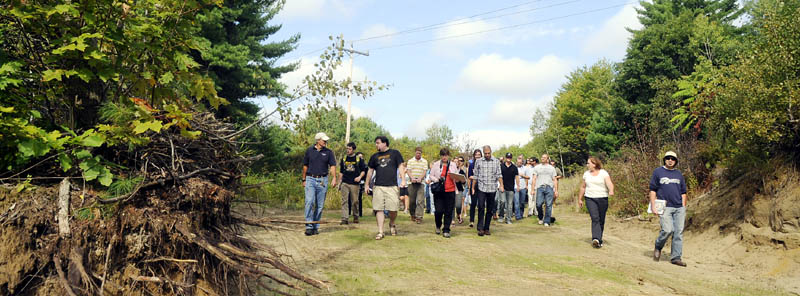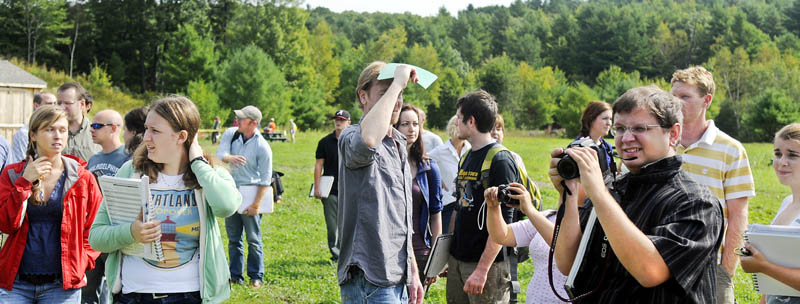AUGUSTA — Mike Hutchins listened intently as Bill Rogers described how ski racers enter and exit the large open “stadium” area at Bond Brook Recreation Area.
He hand-sketched the layout of the land on a pad of paper and later asked questions about how the site will be used.
“As he’s talking, I’m putting his words into pictures,” said Hutchins, a second year architecture student at the University of Maine at Augusta.
Hutchins was one of dozens of UMA architecture students roaming the stadium area on Thursday, the focal point of the roughly 260-acre forested trail system on city-owned land between Bond Brook and the Augusta State Airport. The students were briefed on the many ways organizers see using a multi-use lodge they propose for the site by Rogers, a local doctor, International Skiing Federation official, and guiding force behind the creation, over the last several years, of the Bond Brook Recreation Area.
Students’ task: Design the lodge and provide drawings and a three-dimensional model of it, with their work to be critiqued by both their college professors and organizers of the trail system — who are in essence the clients on the lodge project.
Oh, and do it in just over a week.
“At the end of that, we hope to have a project that works,” said Amy Hinkley, an assistant architecture professor at UMA. “This is very much the beginning of the process, much quicker than normal. We don’t expect them to have completed construction drawings or anything. It’s the start. It’s the sparks, the initial solutions, we’re looking for.”
Shannon Gebo, a fourth-year UMA architecture student, said visiting the site and learning how it will be used is critical.
“We can look at trail maps all day, but without coming out and walking the site, we wouldn’t understand things like how the sunlight moves through the land,” Gebo said.
Proponents of building a lodge at the site said it could serve as a warming hut and base lodge for both recreational and racing cross-country skiers in the winter, a base of operations for bicyclists, hikers and other trail users year round, and offices and meeting space for nonprofit group Augusta Trails, which oversees the trail system, and other users.
When the lodge actually gets built is largely dependent on an ongoing fundraising campaign for the lodge and trail system, Rogers said.
Mike Seitzinger, an Augusta attorney and president of Augusta Trails, said fundraising for the first phase of the trails project, including construction of a new access road into the stadium which will eventually connect to Bond Brook Road, has so far brought in about $425,000 toward their goal of $500,000.
Seitzinger said they don’t yet have an estimate of how much the lodge, part of the planned second phase of the project, will cost. He said they’ll use the initial designs for the lodge to get cost estimates from experts.
The architecture students won’t be given a budget for their design proposals. Hinkley said most aren’t at the point in their educations yet where they could be expected to estimate the cost of the materials and time involved in building their designs. But she said the students are expected to propose sustainable, economical designs that would not be difficult or expensive for the nonprofit lodge owners to maintain.
Andy Shultz, landowner outreach forester with the Maine Forest Service and member of local forestland conservation proponent and project partner Kennebec Woodland Partnership, said part of that sought-after sustainability could include using wood from the many trees on the site to build much of the lodge.
“On 260 acres, I think you could find a buildings-worth of” trees to build the lodge, Shultz told a group of architecture students, one of whom filmed their discussion with him on video. Other students used still cameras to take photos of the site, a large bowl-like spot surrounded by hilly forest.
Rogers, in introducing the site to students, said it could be an ideal spot for spectators to take in Nordic ski races, which on more traditional courses, aren’t terribly spectator-friendly. Rogers said older courses generally consisted of a 15-kilometer (9.3 mile) course through the woods, so the racers are only visible to spectators when they start and finish. The Bond Brook race course features two 2.5-kilometer loops, both of which bring racers back through the stadium area every 10 minutes or so.
Rogers didn’t specifically say where the lodge should go within the stadium area, other than it probably shouldn’t be in a wet area of the site, and needs to provide easy access to the start and finish area, and the access road and parking.
Eric Stark, associate professor and program coordinator at UMA, told students they’ll likely need more information to be successful with their designs than they were likely to get from a quick site visit.
“You’re not going to get everything you need to know today,” Stark told students during the Thursday visit. “When you hear something about wetlands, you immediately should want to know more, like where they are. Because you don’t want to put your building in the middle of them. So you’re going to have to go outside here, outside the school, to get those answers.”
Send questions/comments to the editors.





Success. Please wait for the page to reload. If the page does not reload within 5 seconds, please refresh the page.
Enter your email and password to access comments.
Hi, to comment on stories you must . This profile is in addition to your subscription and website login.
Already have a commenting profile? .
Invalid username/password.
Please check your email to confirm and complete your registration.
Only subscribers are eligible to post comments. Please subscribe or login first for digital access. Here’s why.
Use the form below to reset your password. When you've submitted your account email, we will send an email with a reset code.